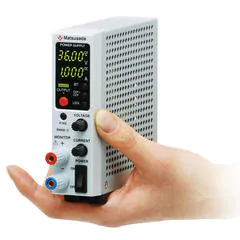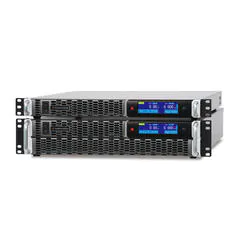- Input Voltage
-
The input voltage range specifies the minimum and maximum voltage input into the power supply that will enable the power supply to perform at the rated levels of output and specifications.
- Max
- Em
- RMS
-
E (rms) =

- Average
-
E (ave) =

AC inputs come in two types, single-phase input and three-phase input (for larger output powers)
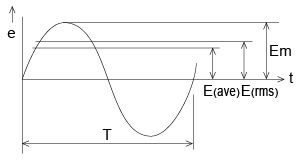
Fig. The sinusoidal AC voltage waveform
- Input Current
-
The input current is the amount of current input to a power supply expressed in RMS. Both series regulators and switching power supplies have capacitive rectifier circuits. This causes the input current waveform to not be sinusoidal but in a waveform as expressed below. The AC waveform of units with PFC (Power Factor Correction) will be sinusoidal.
Input current (rms) =
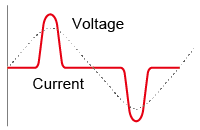
Fig. Input current waveform
- Input Power
-
Because power supplies have capacitive rectification circuits and smoothing circuits, the waveform of the input current will be distorted. The product of the input voltage (RMS) and the input current (RMS) is apparent power. The active power is the time-averaged product of the instantaneous voltage and current over a full cycle. Apparent power is the power that flows in the power supply, active power is the power consumed by the power supply. The gap between the apparent power and active power is the power not utilized, and is returned to the power grid.
- Apparent power = E (rms) x I (rms)
-
Active power =

- Efficiency
-
Efficiency is the ratio of output power to input active power. This value in the specification is at the rated output power. Efficiency is typically highest near the rated load and decreases at very light loads.
-
Efficiency (%) =
 x 100
x 100
- Power Factor
-
Power factor is the ratio of active power to apparent power. In the case of a power supply with capacitive input, the power factor is normally approximately 0.6. A power supply with PFC (Power Factor Correction) is approximately 0.9.
-
Power factor =

- Inrush Current
-
As switching power supplies apply capacitive input circuits, the inrush current can be from multiples of ten to multiples of hundreds of times that of normal operation. Inrush current is the crest value of current that flows when applying an input voltage to a power supply. In series regulators, an inrush current, typically 5 to 10 times the rated steady-state current, occurs. This is primarily caused by the charging of the secondary-side filter capacitor and potential transformer core saturation at power-on.
- Leakage Current
-
Leakage Current is the current specified by the safety regulation of each country or area for safety purposes to avoid electrical shock or other hazardous incidents.
Stray capacity between the primary and secondary transformers, or input to primary components, or current to the ground capacitor of the noise filter is considered as Leakage Current. The diagram below shows how to measure Leakage Current.

Fig. Leakage Current Measurement Circuit
- Line Regulation (Input Regulation)
- Line regulation is the fluctuation of the output voltage when the input voltage is changed within a specified range.
- Load Regulation
-
- Static Load Regulation
Static load regulation is the fluctuation of the output voltage when the load is changed from no load to the rated load.
- Dynamic Load Regulation
Also called transient response time, the dynamic load regulation is the output response time when the load is changed from no load to rated load quickly.
-
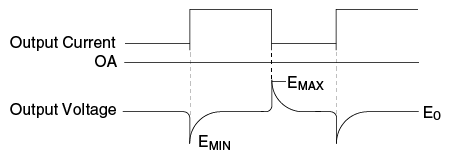
Fig. Dynamic load regulation
- Ripple
-
Ripple is a wave synchronized with the switching frequency and/or input frequency added to the output voltage. Ripple is usually expressed in peak-to-peak terms. When a capacitor is added to the output of a switching power supply, the component of the ripple synchronized with the switching frequency becomes smaller, but the composition synchronized with the input frequency remains the same. For series regulators, the ripple is only the noise synchronized with the input frequency.
- Ripple and Noise
-
Output noise is the combination of periodic ripple and random, high-frequency noise components superimposed on the DC output. It is often specified as PARD (Periodic and Random Deviation). Most switching power supplies use rectangular waveform inverters, so noise from switching transistors or output rectifier diodes is added to the output. Below shows the relation of ripple, output noise, and ripple noise. Series regulators, which lack high-frequency switching components, exhibit significantly lower noise compared to switching power supplies. Their output noise is primarily composed of ripple at the line frequency and its harmonics.
-
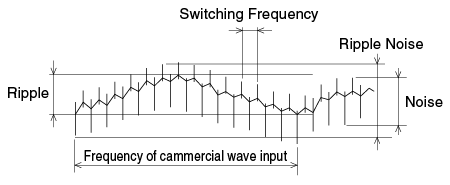
- Design of Heat Radiation
-
As power supplies are a power apparatus, all the differences in conversion efficiency translate into heat radiation. One major component in designing a power supply is the dissipation of heat.
- a. Natural Air-Cooling
-
Natural air-cooling (or convection cooling) dissipates heat via radiation and convection without the use of a fan. Most heat dissipation is done via convection and thus sufficient space for airflow is required. When placing a natural air-cooled power supply inside an enclosure, be sure there is proper ventilation to prevent the accumulation of hot air. Ensuring adequate exhaust ventilation is often more effective than enlarging the intake. Always install the power supply in the specified manner that in which it was designed.
- b. Forced Air-Cooling
-
Forced air-cooled power supplies to use a fan to force air flow to cool the power supply components and therefore control of the ambient temperature is enough to cool the fan. Always be sure that the air intakes or exhaust vents on the power supply are not blocked.
- Remote Control
-
The remote control function is used to turn the power supply on or off, or to toggle the settings of voltage rise or fall times for multiple power supplies. This is a function to turn the power supply output on or off with an external signal. Relay contact transistors or integrated circuits can also be used to power on or off. Depending on the model, LOW = ON and HIGH = OFF or vice versa. Always check the power supply's specification before use.
- Isolation/Dielectric Strength
-
- Isolation Resistance
-
Isolation resistance is the resistance when applying a specified DC voltage between specified terminals.
- Dielectric strength
-
Dielectric voltage is a voltage that does not break the power supply or does not cause a spark discharge when a specified AC voltage is applied between specified terminals. To test the dielectric strength, increase the voltage gradually from 0 V so that rapid voltage change does not cause impulse voltage, or increase the voltage with a zero crossing switch.
- Operating Temperature
-
Operating temperature is the ambient temperature without wind and when placed horizontally, at which the power supply can be operated within its specifications. Avoid placing the power supply vertically or at extreme angles. For forced air-cooled power supplies, the operating temperature is the temperature of airflow into the power supply. The lifetime of the power supply is reduced by 50% for every 10°C rise in temperature. Operating the power supply at as low a temperature as possible (in the specified operating range) will prolong the life of the power supply.
- Storage Temperature
-
Storage temperature is the ambient temperature at which the power supply can be safely stored without deterioration or performance of the power supply. Avoid storing power supplies in hot areas so as not to deteriorate the aluminum electrolytic capacitors within the power supply.
Related Technical Articles
Recommended Products
Matsusada Precision's high-performance power supplies



